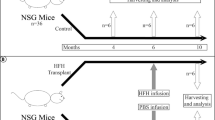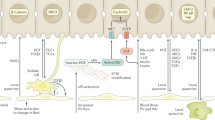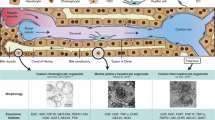Abstract
To provide long-term therapy in patients with severe toxin-induced hepatic parenchymal damage, donor hepatocytes would need to replicate and replace a large portion of the damaged parenchyma. Using a mouse model developed to reproduce this type of hepatic injury, we found that hepatocyte transplantation only slightly improved survival after transplantation despite the fact that many non-survivors showed moderate liver repopulation by donor cells. Perhaps accounting for this outcome, donor parenchyma in non-survivors did not have typical lobular organization. These results indicate that the re-creation of functional parenchyma by transplanted hepatocytes requires time, during which donor cells proliferate and then establish normal parenchymal architecture.
This is a preview of subscription content, access via your institution
Access options
Subscribe to this journal
Receive 12 print issues and online access
$209.00 per year
only $17.42 per issue
Buy this article
- Purchase on Springer Link
- Instant access to full article PDF
Prices may be subject to local taxes which are calculated during checkout






Similar content being viewed by others
References
Fuller, B.J. Transplantation of isolated hepatocytes. A review of current ideas. J. Hepatol. 7, 368–376 (1988).
Mito, M., Kusano, M. & Sawa, M. Hepatocyte transplantation for hepatic failure. Transplant. Rev. 7, 35–43 (1993).
Gupta, S., Gorla, G.R. & Irani, A.N. Hepatocyte transplantation: emerging insights into mechanisms of liver repopulation and their relevance to potential therapies. J. Hepatol. 30, 162–170 (1999).
Habibullah, C.M., Syed, I.H., Qamar, A. & Taher-Uz, Z. Human fetal hepatocyte transplantation in patients with fulminant hepatic failure. Transplantation 58, 951–952 (1994).
Strom, S.C. et al. Hepatocyte transplantation as a bridge to orthotopic liver transplantation in terminal liver failure. Transplantation 63, 559–569 (1997).
Wilson, J.M. et al. Temporary amelioration of hyperlipidemia in low density lipoprotein receptor-deficient rabbits transplanted with genetically modified hepatocytes. Proc. Natl. Acad. Sci. USA 87, 8437–8441 (1990).
Chowdhury, J.R. et al. Long-term improvement of hypercholesterolemia after ex vivo gene therapy in LDLR-deficient rabbits. Science 254, 1802–1805 (1991).
Gunsalus, J.R., Brady, D.A., Coulter, S.M., Gray, B.M. & Edge, A.S. Reduction of serum cholesterol in Watanabe rabbits by xenogeneic hepatocellular transplantation. Nature Med. 3, 48–53 (1997).
Matas, A.J. et al. Hepatocellular transplantation for metabolic deficiencies: decrease of plasmsa bilirubin in Gunn rats. Science 192, 892–894 (1976).
Moscioni, A.D. et al. Long-term correction of albumin levels in the Nagase analbuminemic rat: repopulation of the liver by transplanted normal hepatocytes under a regeneration response. Cell Transplant. 5, 499–503 (1996).
Oren, R. et al. Restoration of serum albumin levels in nagase analbuminemic rats by hepatocyte transplantation. Hepatology 29, 75–81 (1999).
Grossman, M. et al. Successful ex vivo gene therapy directed to liver in a patient with familial hypercholesterolaemia. Nature Genet. 6, 335–341 (1994).
Fox, I.J. et al. Treatment of the Crigler-Najjar syndrome type I with hepatocyte transplantation. N. Engl. J. Med. 338, 1422–1426 (1998).
Lake, J.R. Hepatocyte transplantation. N. Engl. J. Med. 338, 1463–1465 (1998).
Chowdhury, J.R. et al. Human hepatocyte transplantation: gene therapy and more? Pediatrics 102, 647–648 (1998).
Zimmerman, H.J. & Maddrey, W.C. in Diseases of the Liver Vol. 1 (eds. Schiff, L. & Schiff, E.R.) 707–783 (J. B. Lippincott, Philadelphia, 1993).
Lee, W.M. Acute liver failure. Am. J. Med. 96, 3S–9S (1994).
Lee, W.M. Drug-induced hepatotoxicity. N. Engl. J. Med. 333, 1118–1127 (1995).
Cameron, R.G., Feuer, G. & de la Iglesia, F.A. Drug-Induced Hepatotoxicity (Springer-Verlag, Berlin Heidelberg, 1996).
Groth, C.G., Arborgh, B., Bjorken, C., Sundberg, B. & Lundgren, G. Correction of hyperbilirubinemia in the glucuronyltransferase-deficient rat by intraportal hepatocyte transplantation. Transplant. Proc. 9, 313–316 (1977).
Kay, M.A. . et al. Expression of human alpha 1-antitrypsin in dogs after autologous transplantation of retroviral transduced hepatocytes. Proc. Natl. Acad. Sci. USA 89, 89–93 (1992).
Kocken, J.M. et al. Correction of an inborn error of metabolism by intraportal hepatocyte transplantation in a dog model. Transplantation 62, 358–364 (1996).
Borrelli, E., Heyman, R., Hsi, M. & Evans, R.M. Targeting of an inducible toxic phenotype in animal cells. Proc. Natl. Acad. Sci. USA 85, 7572–7576 (1988).
Heyman, R.A. et al. Thymidine kinase obliteration: creation of transgenic mice with controlled immune deficiency. Proc. Natl. Acad. Sci. USA 86, 2698–2702 (1989).
Wallace, H., McLaren, K., al-Shawi, R. & Bishop, J.O. Consequences of thyroid hormone deficiency induced by the specific ablation of thyroid follicle cells in adult transgenic mice. J. Endocrinol. 143, 107–120 (1994).
Brand, K. et al. Liver-associated toxicity of the HSV-tk/GCV approach and adenoviral vectors. Cancer Gene Ther. 4, 9–16 (1997).
Culver, K.W. et al. In vivo gene transfer with retroviral vector-producer cells for treatment of experimental brain tumors. Science 256, 1550–1552 (1992).
Freeman, S.M. et al. The “bystander effect”: tumor regression when a fraction of the tumor mass is genetically modified. Cancer Res. 53, 5274–5283 (1993).
Sandgren, E.P. et al. Complete hepatic regeneration after somatic deletion of an albumin-plasminogen activator transgene. Cell 66, 245–256 (1991).
Kiuchi, T. et al. Impact of graft size mismatching on graft prognosis in liver transplantation from living donors. Transplantation 67, 321–327 (1999).
Sutherland, D.E., Numata, M., Matas, A.J., Simmons, R.L. & Najarian, J.S. Hepatocellular transplantation in acute liver failure. Surgery 82, 124–132 (1977).
Sommer, B.G., Sutherland, D.E., Matas, A.J., Simmons, R.L. & Najarian, J.S. Hepatocellular transplantation for treatment of D-galactosamine-induced acute liver failure in rats. Transplant. Proc. 11, 578–584 (1979).
Makowka, L. et al. Reversal of experimental acute hepatic failure in the rat. J. Surg. Res. 29, 479–487 (1980).
Makowka, L. et al. Studies into the mechanism of reversal of experimental acute hepatic failure by hepatocyte transplantation. Can. J. Surg. 24, 39–44 (1981).
Baumgartner, D., LaPlante-O'Neill, P.M., Sutherland, D.E. & Najarian, J.S. Effects of intrasplenic injection of hepatocytes, hepatocyte fragments and hepatocyte culture supernatants on D-galactosamine-induced liver failure in rats. Eur. Surg. Res. 15, 129–135 (1983).
Birraux, J. et al. Does hepatocyte transplantation in a chemically induced acute hepatic failure make sense? Eur. J. Pediatr. Surg. 8, 224–229 (1998).
Overturf, K. et al. Hepatocytes corrected by gene therapy are selected in vivo in a murine model of hereditary tyrosinaemia type I. Nature Genet. 12, 266–273 (1996).
Heckel, J.L., Sandgren, E.P., Degen, J.L., Palmiter, R.D. & Brinster, R.L. Neonatal bleeding in transgenic mice expressing urokinase-type plasminogen activator. Cell 62, 447–456 (1990).
Brinster, R.L., Chen, H.Y., Trumbauer, M.E., Yagle, M.K. & Palmiter, R.D. Factors affecting the efficiency of introducing foreign DNA into mice by microinjecting eggs. Proc. Natl. Acad. Sci. USA 82, 4438–4442 (1985).
Rhim, J.A., Sandgren, E.P., Degen, J.L., Palmiter, R.D. & Brinster, R.L. Replacement of diseased mouse liver by hepatic cell transplantation. Science 263, 1149–1152 (1994).
Kisseberth, W.C., Brettingen, N.T., Lohse, J.K. & Sandgren, E.P. Ubiquitous expression of marker transgenes in mice and rats. Dev. Biol. 214, 128–138 (1999).
Klaunig, J.E. et al. Mouse liver cell culture. I. Hepatocyte isolation. In Vitro 17, 913–925 (1981).
Smith, D.D., Jr. & Campbell, J.W. Distribution of glutamine synthetase and carbamoyl-phosphate synthetase I in vertebrate liver. Proc. Natl. Acad. Sci. USA 85, 160–164 (1988).
Overturf, K., al-Dhalimy, M., Ou, C.N., Finegold, M. & Grompe, M. Serial transplantation reveals the stem-cell-like regenerative potential of adult mouse hepatocytes. Am. J. Pathol. 151, 1273–1280 (1997).
Acknowledgements
We thank P. MacWilliams for assistance and discussions regarding blood chemistry analysis, M. Bowden for assistance with surgeries and computer image analysis, and R. Szakaly for assistance with figures. This work has been supported by National Institutes of Health grant R01-DK49787 to E.P.S., and by a National Science Foundation predoctoral fellowship to K.M.B.
Author information
Authors and Affiliations
Corresponding author
Rights and permissions
About this article
Cite this article
Braun, K., Degen, J. & Sandgren, E. Hepatocyte transplantation in a model of toxin-induced liver disease: variable therapeutic effect during replacement of damaged parenchyma by donor cells. Nat Med 6, 320–326 (2000). https://doi.org/10.1038/73179
Received:
Accepted:
Issue Date:
DOI: https://doi.org/10.1038/73179
This article is cited by
-
Biosafety in Ex Vivo Gene Therapy and Conditional Ablation of Lentivirally Transduced Hepatocytes in Nonhuman Primates
Molecular Therapy (2009)
-
Principles of therapeutic liver repopulation
Journal of Inherited Metabolic Disease (2006)
-
Liver gene therapy: advances and hurdles
Gene Therapy (2004)
-
Portal hemodynamic changes after hepatocyte transplantation in acute hepatic failure
Journal of Biomedical Science (2004)
-
Conditional cell ablation by tight control of caspase-3 dimerization in transgenic mice
Nature Biotechnology (2002)



